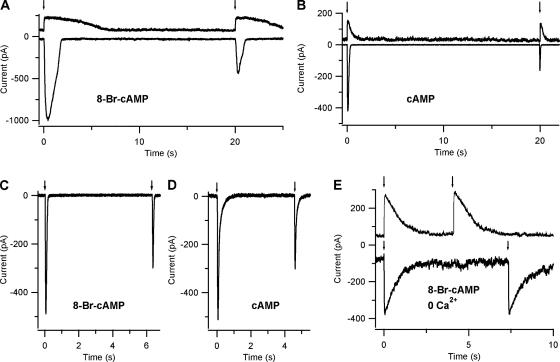Figure 4.
Response adaptation to photorelease of cAMP or 8-Br-cAMP. Different olfactory sensory neurons were loaded with 50 μM caged 8-Br-cAMP (A, C, and E) or with 250 μM caged cAMP (B and D). A and B show current responses to repetitive light flashes of the same maximal intensity at interflash interval of 20 s in two neurons with similar adaptation properties. In each panel, recordings at +50 mV (top traces) and at −50 mV (bottom traces) were obtained from the same neuron. The two selected neurons showed similar adaptation in 8-Br-cAMP (A) and cAMP (B). At −50 mV, the peak amplitudes of the responses to the second flash (−403 pA, −160 pA) were 42% and 38% of the responses to the first flash (−951 pA, −421 pA) for 8-Br-cAMP (A) or cAMP (B), respectively. At +50 mV, the peak amplitudes of current responses to repetitive flashes were very similar, indicating the absence of adaptation. C and D show two neurons in which adaptation was measured at interflash intervals of 6.3 s (C) or 4.6 s (D). The two selected neurons showed similar adaptation in 8-Br-cAMP (C) and cAMP (D). At −50 mV, the peak amplitudes of the responses to the second flash (−298 pA, −302 pA) were 61% and 59% of the responses to the first flash (−488 pA, −511 pA) for 8-Br-cAMP (C) or cAMP (D), respectively. (E) Control experiment in a different neuron in nominally 0 Ca2+ Ringer solution, where the absence of Ca2+ entry prevented both adaptation and the activation of the Ca2+-activated Cl− channel. Currents to repetitive flashes of the same maximal intensity photoreleasing 8-Br-cAMP reached a similar amplitude both at +50 mV (226 and 225 pA), and at −50 mV (−306 and −290 pA), indicating the photorelease of the same 8-Br-cAMP concentration. Control experiments in 0 Ca were obtained in a total of five neurons.

